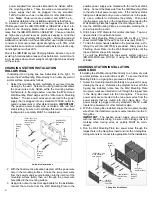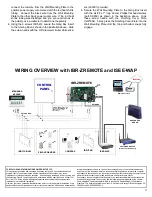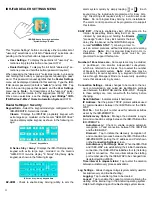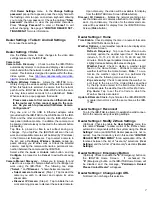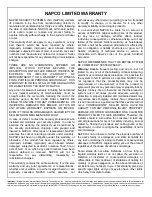
3
connect the red wire from the Wall Mounting Plate to the
positive power supply wire marked with the red heat shrink
tubing. Connect the black wire from the Wall Mounting
Plate to the other black power supply wire. If the red heat
shrink tubing was dislodged and you are uncertain as to
the polarity, use a voltmeter to determine the polarity.
4. Using the 6 screws (SC523), secure the Gang Box Insert
to the 3-Gang Box as shown in the illustration above. Hide
the screw heads with the 3/8" diameter circular white stick-
ers (LA3001) provided.
5. Secure the Wall Mounting Plate to the Gang Box Insert
with the six #6 x 1" long Hi-Low Phillips flat head screws
(part SC652) as shown in the illustration above. Hide
these screw heads with the Finishing Cover Plate
(HW1854). Firmly press the Finishing Cover Plate into the
Wall Mounting Plate until the top and bottom snaps fully
engage.
IBR-ZREMOTE
CUSTOMER ROUTER
(Wireless or Wired-only)
WIRING OVERVIEW with IBR-ZREMOTE and ISEE-WAP
KEYPAD BUS
BROADBAND
MODEM
TO PANEL SERIAL PORT (only
needed for IBR-ZREMOTE CS
communication or panel
downloading)
NETWORK
CONTROL
PANEL
STANDARD
KEYPAD
Internet
RE
D
BL
A
C
K
GR
E
E
N
Y
E
LLO
W
GR
E
E
N
YE
LL
OW
RE
D
B
L
AC
K
ISEE-WAP
IBR-ITAB-HW
CAMERAS
(
(
(
(
(
(
IBR-ITAB
(
(
(
(
(
(
NETWORK
(
(
(
(
(
(
Remote Services
(
(
(
Z-WAVE DEVICES
THE FOLLOWING STATEMENT IS REQUIRED BY THE FCC.
This equipment generates and uses radio-frequency energy and, if not installed and used
properly, that is, in strict accordance with the manufacturer's instructions, may cause
interference to radio and television reception. It has been type tested and found to comply with
the limits for a Class-B computing device in accordance with the specifications in Subpart J of
Part 15 of FCC Rules, which are designed to provide reasonable protection against such
interference in a residential installation.
However, there is no guarantee that interference will not occur in a particular installation. If this
equipment does cause interference to radio or television reception, which can be determined by
turning the equipment off and on, the user is encouraged to try to correct the interference by
one or more of the following measures: reorient the receiving antenna; relocate the computer
with respect to the receiver; move the computer away from the receiver; plug the computer into
a different outlet so that computer and receiver are on different branch circuits.
If necessary, the user should consult the dealer or an experienced radio/television technician
for additional suggestions. The user may find the following booklet prepared by the Federal
Communications Commission helpful: “How to Identify and Resolve Radio-TV Interference
Problems”. This booklet is available from the U.S. Government Printing Office, Washington, DC
20402; Stock No. 004-000-00345-4.


